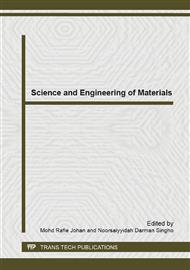[1]
Z. Hamzah, A. Saat, A. K. Wood, Z. A. Bakar, A. S. Area, Sedimentation , Heavy Metals Profiles and Cluster Analysis of a Former Tin Mining Lake, Int. J. Environ. Technol. Manage. 2 (2011) 448-453.
DOI: 10.7763/ijesd.2011.v2.167
Google Scholar
[2]
B. Pejic, M. Vukcevic, M. Kostic, P. Skundric, Biosorption of heavy metal ions from aqueous solutions by short hemp fibers: Effect of chemical composition, J. Hazard. Mater. 164 (2009) 146–153.
DOI: 10.1016/j.jhazmat.2008.07.139
Google Scholar
[3]
A. Demirbas, Heavy metal adsorption onto agro-based waste materials : A review, J. Hazard. Mater. 157 (2008) 220–229.
DOI: 10.1016/j.jhazmat.2008.01.024
Google Scholar
[4]
W. S. W. Ngah, M. A. K. M. Hanafiah, Adsorption of copper on rubber (Hevea brasiliensis) leaf powder : Kinetic, equilibrium and thermodynamic studies, J. Environ. Sci. l (2008a) 521–530.
DOI: 10.1016/j.bej.2007.11.006
Google Scholar
[5]
D. Chauhan and N. Sankararamakrishnan (2008). Highly enhanced adsorption for decontamination of lead ions from battery wastewaters using chitosan functionalized with xanthate., Bioresource Technology 99(18): 9021-9024.
DOI: 10.1016/j.biortech.2008.04.024
Google Scholar
[6]
W. S. W. Ngah and M. A. K. M. Hanafiah, Biosorption of copper ions from dilute aqueous solutions on base treated rubber (Hevea brasiliensis) leaves powder : kinetics, isotherm and biosorption mechanisms, J. Environ. Sci. 20 (2008b) 1168–1176.
DOI: 10.1016/s1001-0742(08)62205-6
Google Scholar
[7]
M.A.K.M. Hanafiah, W.S. Ngah, S.C. Ibrahim, H. Zakaria, W.A.H. W Alias, Kinetics and thermodynamic study of lead adsorption from aqueous solution onto rubber (Hevea brasiliensis) leaf powder, J. Appl Sci. 6 (2006) 2762-2767.
DOI: 10.3923/jas.2006.2762.2767
Google Scholar
[8]
Z. Wu, Z. Cheng, W. Ma, Adsorption of Pb(II) from glucose solution on thiol-functionalized cellulosic biomass, Bioresour. Technol. 104 (2012) 807-809.
DOI: 10.1016/j.biortech.2011.10.100
Google Scholar
[9]
A.E. Ofomaja, E.B. Naidoo, S.J. Modise, Biosorption of copper(II) and lead(II) onto potassium hydroxide treated pine cone powder, J. Environ. Manage. 91 (2010) 1674-1685.
DOI: 10.1016/j.jenvman.2010.03.005
Google Scholar
[10]
Y. Xue, B. Gao, Y. Yao, M. Inyang, M. Zhang, A.R. Zimmermann, Hydrogen peroxide modification enhances the ability of biochar (hydrochar) produced from hydrothermal carbonization of peanut hull to remove aqueous heavy metals: Batch and column tests, Chem. Eng. J. 200-202 (2012).
DOI: 10.1016/j.cej.2012.06.116
Google Scholar
[11]
G. Tan, H. Yuan, Y. Liu, D. Xiou, Removal of lead from aqueous solution with native and chemically modified corncorbs, J. Hazard. Mater. 174 (2010) 740-745.
DOI: 10.1016/j.jhazmat.2009.09.114
Google Scholar


